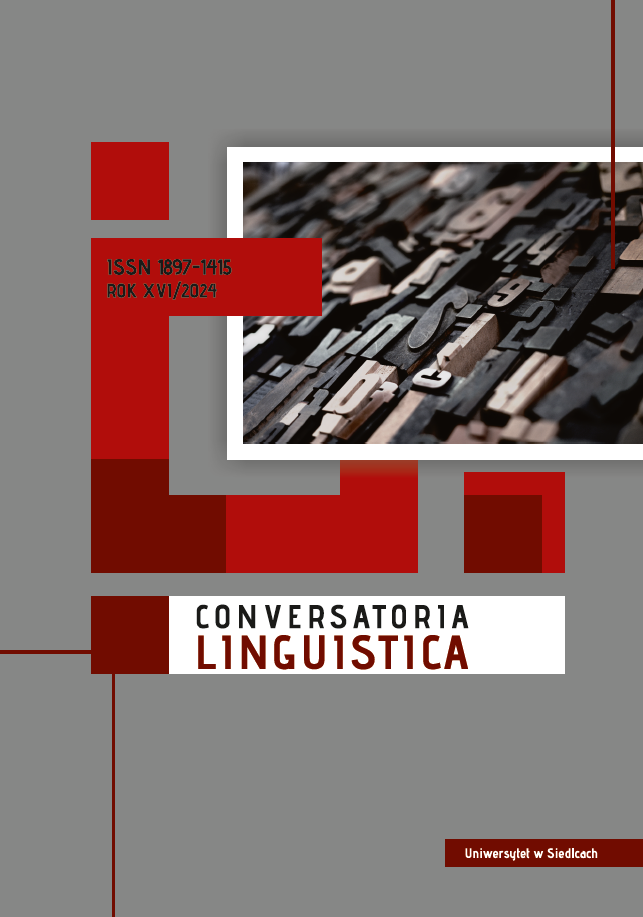Naturalny metajęzyk semantyczny jako narzędzie mediacji komunikacyjnej w nauczaniu i uczeniu się języków
DOI:
https://doi.org/10.34739/clg.2024.16.01Słowa kluczowe:
naturalny metajęzyk semantyczny (NSM), Europejski system opisu kształcenia językowego (ESOKJ), nauczanie i uczenie się języków, mediacja, formuły powitalneAbstrakt
W artykule staramy się wdrożyć podejście naturalnego metajęzyka semantycznego (NSM) jako narzędzia mediacji komunikacyjnej na lekcjach języka obcego. Mediacja to ważny termin wprowadzony do nauczania i uczenia się języków przez Europejski system opis kształcenia językowego (CEFR 2001) oraz rozwinięty w tomie uzupełniającym CEFR/CV (2020). Odnosi się do jednego z czterech typów działań komunikacyjnych (recepcja, produkcja, interakcja i mediacja), w którym przedstawia się społeczny wymiar języka, a użytkownik języka postrzegany jest jako social agent, uczestnik życia społecznego. Język sam w sobie jest ważnym narzędziem mediacji, natomiast minijęzyk wywodzący się z dowolnego ludzkiego języka jeszcze bardziej ułatwia objaśnianie znaczenia pojęć. Może być przydatny zarówno w konstruowaniu i współkonstruowaniu nowych znaczeń, jak i w przekazywaniu informacji, zwłaszcza w kontekstach wielokulturowych. Będąc wolnym od etnocentrycznych uprzedzeń, NSM może zapewnić jasną i skuteczną strategię radzenia sobie z „innością” i tworzenia neutralnej, bezpiecznej przestrzeni komunikacyjnej. Aby zilustrować jego skuteczność, podamy kilka przykładów, wyjaśniając za pośrednictwem NSM, jak zwodniczo podobne pojęcia, takie jak nazwy pór dnia, zwłaszcza te używane w powitaniach, różnią się w języku hiszpańskim, angielskim i polskim.
Pobrania
Bibliografia
Literature
Agar M. (1994): Language Shock. Understanding the Culture of Conversation, New York.
Council of Europe (1998): Threshold 1990, Cambridge, URL: https://www.ealta.eu.org/ documents/resources/Threshold-Level_CUP.pdf.
Council of Europe (2001): Common European Framework of Reference for Languages: Learning, Teaching, Assessment, Cambridge. URL: https://rm.coe.int/1680459f97.
Council of Europe (2020): Common European Framework of Reference for Languages: Learning, Teaching, Assessment. Companion Volume, Strasbourg. URL: https://rm.coe. int/common-european-framework-of-reference-for-languages-learning-teaching/ 16809ea0d4.
Ek J. van (1975): Systems development in adult language learning. The threshold level in a European unit/credit system for modern language learning by adults. Strasbourg. URL: https://open.books4languages.com/project/wp-content/uploads/si-tes/23/2017/01/The_Threshold_Level_in_a_European_UnitCredit_system_for_mo-dern_language_learning_by_adults.pdf.
Farese G.M. (2015): Hi vs. Ciao: NSM as a tool for cross-linguistic pragmatics, “Journal of Pragmatics”, no 85, p. 1–17.
Farese G.M. (2018): The Cultural Semantics of Address Practices, Lanham.
Fernández S. (2016): Possible contributions of Ethnopragmatics to second language learning and teaching, in: Let us have articles betwixt us –Papers in Historical and Comparative Linguistics in Honour of Johanna L. Wood, eds. S. Vikner, H. Jørgensen & E. van Gelderen, Aarhus University, p. 185–206.
Goddard C. (2010): Semantic molecules and semantic complexity (with special reference to “environmental” molecules), “Review of Cognitive Linguistics”, no 8(1), p. 123–155.
Goddard C. (2018): Ten Lectures on Natural Semantic Metalanguage, Leiden.
Goddard C., Wierzbicka A. (2007): Semantic primes and cultural scripts in language learning and intercultural communication, in: Applied Cultural Linguistics: Implications for Second Language Learning and Intercultural Communication, eds. G. Palmer, F. Sharifian, Amsterdam, p. 105–124.
Goddard C., Wierzbicka A. (2014): Words and Meanings. Lexical Semantics Across Dom-ins, Languages, and Cultures, Oxford.
Grucza F. (1991): Terminologia. Jej przedmiot, status i znaczenie, w: Teoretyczne podstawy terminologii, ed. Franciszek Grucza, Wrocław, p. 11–44.
Martyniuk W. (2021): ESOKJ 2020: nowy, zmodernizowany europejski system opisu kształcenia językowego, ”Postscriptum Polonistyczne”, no 28(2), p. 1–18.
North B. (2016): Developing CEFR illustrative descriptors of aspects of mediation, “Inter-national Online Journal of Education and Teaching (IOJET)”, no 3(2), p. 132–140. URL: http://iojet.org/index.php/IOJET/article/view/125/131.
North B., Piccardo E. (2016): Developing illustrative descriptors of aspects of mediation for the Common European Framework of Reference (CEFR), Strasbourg.
Piccardo E., North B., Goodier T. (2019): Broadening the Scope of Language Education: Mediation, Plurilingualism, and Collaborative Learning: the CEFR Companion Volume. “Journal of e-Learning and Knowledge Society”, no 15(1), p. 17–36.
Sadow L., Fernández S. (2022): Pedagogical pragmatics: natural semantic metalanguage applications to language learning and teaching, “Scandinavian Studies in Language”, no 13(1), p. 53–66.
Trim J.L.M (1975): Foreword, [in:] Threshold Level English, ed. J. van Ek, Oxford, p. 102– –104. URL: https://rm.coe.int/threshold-level-series-prefaces-introductions-serie-nive-aux-seuils-pre/168077c54b.
Wierzbicka A. (1991): Cross-Cultural Pragmatics, Berlin.
Wierzbicka A. (1996): Semantics: Primes and Universals, Oxford.
Wierzbicka A. (2013): Imprisoned in English. The Hazards of English as a Default Language, Oxford.
Internet sources
Goddard C. (2021): The Molecules Project (a conference presentation given at NSM-Con21 on 15th April 2021), 9 VII 2024.
Longman Dictionary of Contemporary English, https://www.ldoceonline.com/about.html, 9 VII 2024.
Marcjanik M. (2006): Dzień dobry czy dobry wieczór?, SJP PWN, https://sjp.pwn.pl/ poradnia/haslo/Dzien-dobry-czy-Dobry-wieczor;6906.html, 9 VII 2024.
What is NSM?, https://intranet.secure.griffith.edu.au/schools-departments/natural-se-mantic-metalanguage/what-is-nsm, 9 VII 2024.
Pobrania
Opublikowane
Numer
Dział
Licencja
Prawa autorskie (c) 2024 Conversatoria Linguistica

Utwór dostępny jest na licencji Creative Commons Uznanie autorstwa – Użycie niekomercyjne 4.0 Międzynarodowe.




